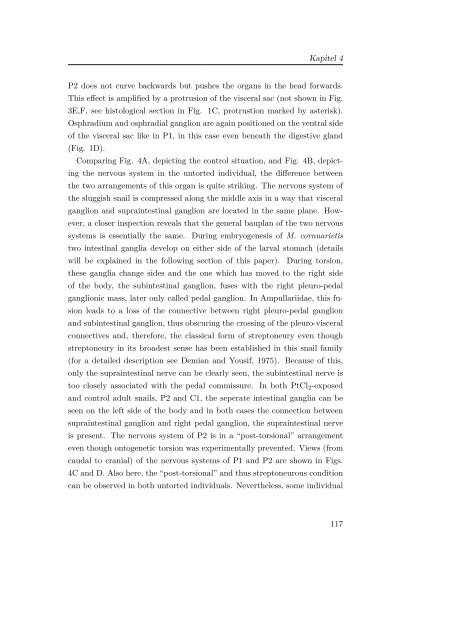Die Embryonalentwicklung der Paradiesschnecke ... - TOBIAS-lib
Die Embryonalentwicklung der Paradiesschnecke ... - TOBIAS-lib
Die Embryonalentwicklung der Paradiesschnecke ... - TOBIAS-lib
You also want an ePaper? Increase the reach of your titles
YUMPU automatically turns print PDFs into web optimized ePapers that Google loves.
Kapitel 4<br />
P2 does not curve backwards but pushes the organs in the head forwards.<br />
This effect is amplified by a protrusion of the visceral sac (not shown in Fig.<br />
3E,F, see histological section in Fig. 1C, protrustion marked by asterisk).<br />
Osphradium and osphradial ganglion are again positioned on the ventral side<br />
of the visceral sac like in P1, in this case even beneath the digestive gland<br />
(Fig. 1D).<br />
Comparing Fig. 4A, depicting the control situation, and Fig. 4B, depicting<br />
the nervous system in the untorted individual, the difference between<br />
the two arrangements of this organ is quite striking. The nervous system of<br />
the sluggish snail is compressed along the middle axis in a way that visceral<br />
ganglion and supraintestinal ganglion are located in the same plane. However,<br />
a closer inspection reveals that the general bauplan of the two nervous<br />
systems is essentially the same. During embryogenesis of M. cornuarietis<br />
two intestinal ganglia develop on either side of the larval stomach (details<br />
will be explained in the following section of this paper). During torsion,<br />
these ganglia change sides and the one which has moved to the right side<br />
of the body, the subintestinal ganglion, fuses with the right pleuro-pedal<br />
ganglionic mass, later only called pedal ganglion. In Ampullariidae, this fusion<br />
leads to a loss of the connective between right pleuro-pedal ganglion<br />
and subintestinal ganglion, thus obscuring the crossing of the pleuro-visceral<br />
connectives and, therefore, the classical form of streptoneury even though<br />
streptoneury in its broadest sense has been established in this snail family<br />
(for a detailed description see Demian and Yousif, 1975). Because of this,<br />
only the supraintestinal nerve can be clearly seen, the subintestinal nerve is<br />
too closely associated with the pedal commissure. In both PtCl 2 -exposed<br />
and control adult snails, P2 and C1, the seperate intestinal ganglia can be<br />
seen on the left side of the body and in both cases the connection between<br />
supraintestinal ganglion and right pedal ganglion, the supraintestinal nerve<br />
is present. The nervous system of P2 is in a “post-torsional” arrangement<br />
even though ontogenetic torsion was experimentally prevented. Views (from<br />
caudal to cranial) of the nervous systems of P1 and P2 are shown in Figs.<br />
4C and D. Also here, the “post-torsional” and thus streptoneurous condition<br />
can be observed in both untorted individuals. Nevertheless, some individual<br />
117
















